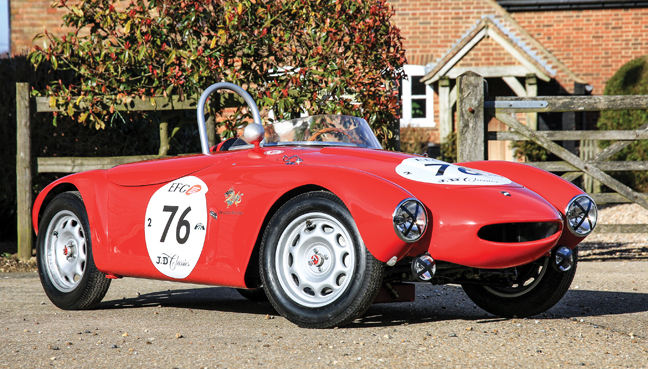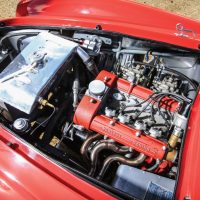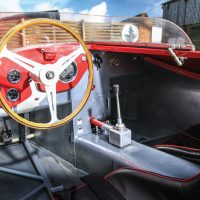SCM Analysis
Detailing
| Vehicle: | 1955 Moretti 750 Gran Sport Barchetta |
| Years Produced: | 1953–56 |
| Number Produced: | Unknown — not many |
| Original List Price: | $4,200 |
| SCM Valuation: | $183,000 |
| Tune Up Cost: | $450 |
| Chassis Number Location: | Plate on engine bulkhead |
| Engine Number Location: | Bottom left side of block |
| Website: | http://Etceterini.com |
| Alternatives: | 1956–60 OSCA 750S, 1956–60 Fiat Abarth 750, 1956–57 Stanguellini 750 Sport |
| Investment Grade: | B |
This car, Lot 172, sold for $177,470, including buyer’s commission, at the RM Sotheby’s auction in Paris, France, on February 5, 2020.
A good friend of mine is a serious collector and vintage racer. Over the years, he has owned and raced many of the most jaw-dropping and important cars known, but the biggest grins I have seen when he comes off the track are when he is driving his Sprite.
Lots of exotic cylinders, insane market values and genuflecting spectators have nothing to do with how much fun something is to drive — in fact, sometimes it’s just the opposite.
Little and weird can have an honored place at the table.
Everybody knows about Fiat, Ferrari, Maserati and Alfa Romeo, and a few even understand Lancia, but in Italy during the early post-war years there was an amazing number of small, enthusiastic manufacturers following the dream of creating specialty cars for the few people wanting to buy them.
The generic term for these has become “Etceterini.” Most of the manufacturers built cars based on available Fiat components with their own modifications and bodywork, but a few, particularly OSCA and Moretti, actually built complete cars.
Hello, Moretti
Giovanni Moretti founded his company in 1925 to build motorcycles, expanding into microcars through the 1930s. During World War II, the company did well building light commercial vehicles, particularly electric trucks for the gas-rationing times.
With peace, Moretti went back to building very small gasoline-powered cars using their own 600-cc and 750-cc engines. Based in Turin, Moretti built a full range of cars, mostly sedans, using a pushrod 4-cylinder engine.
However, being Italian, Moretti also built some Grand Sport barchettas and coupes — using an aluminum twin-cam head and high-performance internals — to go racing.
Moretti did well for a while, but increasingly couldn’t compete with the high-production Fiat 600s on price. By the late 1950s, Moretti gave up being a complete manufacturer in favor of modifying Fiats. The company managed to survive that way into the 1980s. For a brief, halcyon period in the mid-1950s, though, they flourished and managed to build a few very special little performance cars. Nobody seems to know how many of the Grand Sports (both coupe and barchetta) got built, but it’s not a large number. They’ve always been hen’s-teeth rare.
Small, cute and serious
The Grand Sport Morettis are extremely cool, tiny cars, with the emphasis being on tiny.
Until you have physically been around one, you have no concept of how small they are. The wheelbase is three inches shorter and three inches narrower than a Mini Minor, and the car barely comes to your waist, even on 15-inch wheels.
Most people’s response to them is like meeting a puppy or kitten; your knees go soft and invariably a grin comes across your face. It’s just so cute!
I’ve never tried to get into one, but contemporary road tests suggest that there is more room inside that you’d expect. Drivers tended to be scrawnier back then, so the reported roominess may be a function of expectations, not space.
The engine is a jewel to look at, with wide-set twin cams and the smallest twin-choke Webers you’ve ever seen. It supposedly makes something like 70 horsepower at 7,500 rpm, which is impressive for 750 cc. The whole car weighs about 1,250 pounds, so it isn’t exactly slow.
The tests said it will reach 100 mph, although it takes 30 seconds to get there. Light and tiny, the handling is extremely nimble, and the fact that it is so narrow makes any winding road just that much wider when driving a racing line.
All of this gets us to the most basic point: Although this car is tiny and cute, it is in fact a very serious and competent Italian racing car of the mid-1950s.
It has a tubular frame, the bodywork is bespoke aluminum and it’s perfectly capable of running as long and far as you ask it.
In the 1956 Mille Miglia the larger cars had the spotlight, but there were 34 cars that finished in the 750-cc class (this car, or one just like it, started the race but didn’t finish). Small was more normal than big in those days, and they’ll do just as much if not as quickly.
Hard to find
Another big factor is that GS Morettis are very rare — and thus special.
A huge factor in the value and desirability of any racing car is which parties you can get invited to attend, and the most desirable are, by definition, the most exclusive.
Any organizer faced with an overabundance of entries will try to get as much diversity into the field as possible to make for a good show, which means selecting the weird and special entrants over the commonplace. Something like this Moretti is virtually guaranteed an entry at events such as the Mille Miglia Storica, Classic Le Mans or Goodwood.
Why it’s not a million-dollar car
Let’s step back and look at the entire package. It’s Italian, with a tube frame and bespoke aluminum bodywork.
It has a twin-cam, hemispherical-head engine with Webers that will happily rev to or past 7,500 rpm all day long. It is red, very rare and attractive.
Although this car’s particular history is uncertain, it is unquestionably real, and it — or its sister cars — have extensive history in major international events.
It is by all accounts a giggle to drive, although fitting into it may be an issue for a large driver. It is welcome and will be a center of attention at virtually any major racing event worldwide. Except for the engine size, this would be a guaranteed recipe for a million-dollar car, minimum.
Morettis or, for that matter, any of the Etceterini cars, are not for everyone.
They tend to be fragile, and parts are difficult-to-impossible to find when they inevitably break, so they can be high maintenance.
More to the point is that collectors of Italian racing cars tend to take themselves and their cars very seriously: They are, after all, important and valuable items.
This doesn’t work for Etceterini owners, as successful enjoyment requires a sly grin and a twinkle in the eye as you bounce around in something that confounds expectations and is simultaneously impressive and flat-out cute. It requires a different attitude.
To the right owner, this can be a fabulous car and a low-cost entry into the coolest events, but it does come across as a bit of a toy.
It’s not, though. For what it is and what you can do with it, I would say it was very well bought. ♦




